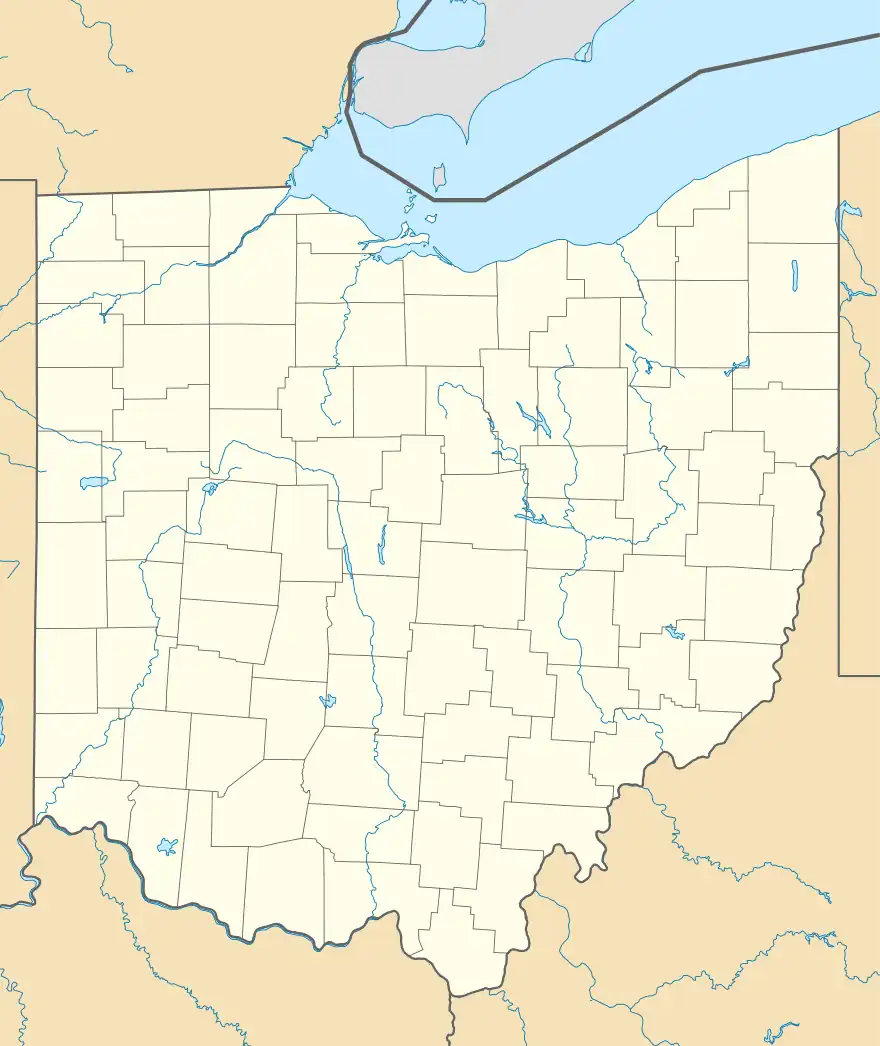Edward D. Libbey House
The Edward D. Libbey House is a historic house museum at 2008 Scottwood Avenue in Toledo, Ohio. Built in 1895, it was the home of Edward Libbey (1854-1925), a businessman who revolutionized the glass making industry in the United States. Libbey and his wife, Florence Scott Libbey would later establish the Toledo Museum of Art in 1901.[3]
Edward D. Libbey House | |
.jpg.webp) | |
  | |
| Location | 2008 Scottwood Ave., Toledo, Ohio |
|---|---|
| Coordinates | 41°38′32″N 83°33′29″W |
| Area | less than one acre |
| Built | 1895 |
| Architect | David L. Stine |
| Architectural style | Shingle Style |
| Website | http://libbeyhouse.org/ |
| Part of | Old West End District (ID73001503) |
| NRHP reference No. | 83004379 |
| Significant dates | |
| Added to NRHP | May 4, 1983[1] |
| Designated NHL | May 4, 1983[2] |
| Designated CP | March 14, 1973 |
It was declared a National Historic Landmark in 1983.[2][4] The property was purchased in 2008 by The Libbey House Foundation with the intent to restore the house to its original condition[5]
Description and history
The Edward D. Libbey House is located in the Old West End District, at the corner of Scottwood Avenue and Woodruff Avenue. It is a Shingle style home designed by architect David L. Stine and built in 1895. It is 2+1⁄2 stories in height, with a foundation of fieldstone and brick, and a shingled exterior. It has asymmetrical massing typical of the style, with gables of varying size, projecting and recessed sections, and a porch supported by clusters of Tuscan columns.[4]
Edward Libbey, a native of Massachusetts, was trained in the manufacture of glass at the New England Glass Company, and came to Toledo in 1888, where he established a new glass works with former employees of that firm. Working with inventor Michael Joseph Owens, Libbey proceeded to revolutionize the manufacture of glass, creating automated equipment for producing all manner of glass products, including light bulbs, bottles, glass tubing, and window glass. He eventually founded several different firms in support of these and other innovations.[4]
Libbey owned the house until is death in 1925; it is the only significant surviving architectural artifact associated with his life. It remained a private residence until 1965, when it was purchased by the Toledo Society for the Handicapped.[4] It is now owned and operated by a dedicated non-profit charity.
Gallery
.jpg.webp) Exterior of Libbey House, 2018
Exterior of Libbey House, 2018.jpg.webp) Exterior of Libbey House, 2018
Exterior of Libbey House, 2018.jpg.webp) Historical marker outside of Libbey House, 2018
Historical marker outside of Libbey House, 2018.jpg.webp) Historical marker outside of Libbey House, 2018
Historical marker outside of Libbey House, 2018 Blueprint of Libbey House detailing first floorplan, 1895
Blueprint of Libbey House detailing first floorplan, 1895 Blueprint of Libbey House detailing second floorplan, 1895
Blueprint of Libbey House detailing second floorplan, 1895 Blueprint of Libbey House detailing north exterior elevation, 1895
Blueprint of Libbey House detailing north exterior elevation, 1895 The Libbey House in 2011 prior to renovations done by the Libbey House Foundation
The Libbey House in 2011 prior to renovations done by the Libbey House Foundation
See also
References
- "National Register Information System". National Register of Historic Places. National Park Service. January 23, 2007.
- "Edward D. Libbey House". National Historic Landmark summary listing. National Park Service. Archived from the original on January 19, 2008. Retrieved April 29, 2008.
- "Historic Date Observed Jan. 17 at Toledo Museum of Ar" (PDF). Toledo Museum of Art. January 5, 2012. Archived from the original (PDF) on June 10, 2012. Retrieved October 18, 2023.
- Ralph J. Christian (December 1977). "National Register of Historic Places Inventory-Nomination: Edward D. Libbey House / Toledo Society for the Handicapped" (pdf). National Park Service.
{{cite journal}}: Cite journal requires|journal=(help) and Accompanying five photos, exterior and interior, from 1977 (32 KB) - "History – The Libbey House – Historic Libbey House Foundation". Retrieved October 18, 2023.